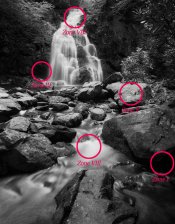Ok, now you admit that Negative films have more highlight latitude than shadow latitude... rectification wellcome.
Of course linear films are less suitable for a raw ZS treatment, but ZS practitioners address linear film usage in several ways.
First, let me mention that "Mr Zone" John Sexton worked with Kodak to develop T-Max film, which is essentially linear in nature, being he both a ZS amazing 1st rate teacher and a T-Max defender, having crafted a top quality body of work with ZS and his linear TMX.
Let me reiterate that ZS "workflow rules" are simple common sense. The spot meter serves to ensure shadows have enough exposure and that highlights don't reach excessive densities after development, common sense... ZS adds nothing to what any fine print maker would do
But the important thing is that Spot metering also helps you in the print visualization. You locate the zones in the scene and so you can realize how the print will be. The important concept is
VISUALIZATION. This helps your creative process.
View attachment 262620
http://www.alanbrockimages.com/blog/2015/5/30/how-to-meter-using-the-zone-system
_______
Now, if you want we may explore several ways we have to process/print extreme highlights from linear film... several may by used additionally.
1) Silver Chloride paper sporting a long Toe which prints the "film shoulder", what was AZO, now Lodima or Lupex.
2) Pyro + Variable Contrast paper. The stronger proportional stain selectively blocks more blue light of the enlarger in the highlights, selectively printing highlights with a lower contrast grade, performing a selective highlight compression or compensation.
3) Compensating development, low/minimal agitation and/or compensating developers.
4) Burning manipulation
5) HLM masking
6) etc...
None of those is in favor or aganist ZS,
today we don't have to play the 1940 ZS as a dogma. While basic rule (Visualization) has not changed, but in those 80 years the ZS way has incorporated all technical advances happened in those 8 decades, being "Mr Zone" himself a powerful drive in that evolution, and
THE main promotor of linear film.
Look, today ZS way is mostly about taking the spot meter to acknowledge the scene so we can Visualize the print we'll get. Making the scene dynamic range fit in the paper is the same problem than in 1940, today we have other materials and new techniques. It is irrelevant what technique we use. The important thing is how we map the scene scale to the paper scale, the ample light range of the scene to the reduced density range in the paper.
ZS is about that, how we paint a rock with shades of gray to make it look 3D (for example), and how we Visualize the print before shutter release, usually after exploring the scene with an spot meter, locating the zones helps the Visualization.
Watch those videos by Mr Zone Sexton...
Let me point that again:
Anyone machinegunning ZS may have a problem... if wanting to put a print in the same wall than Mr Zone

.





